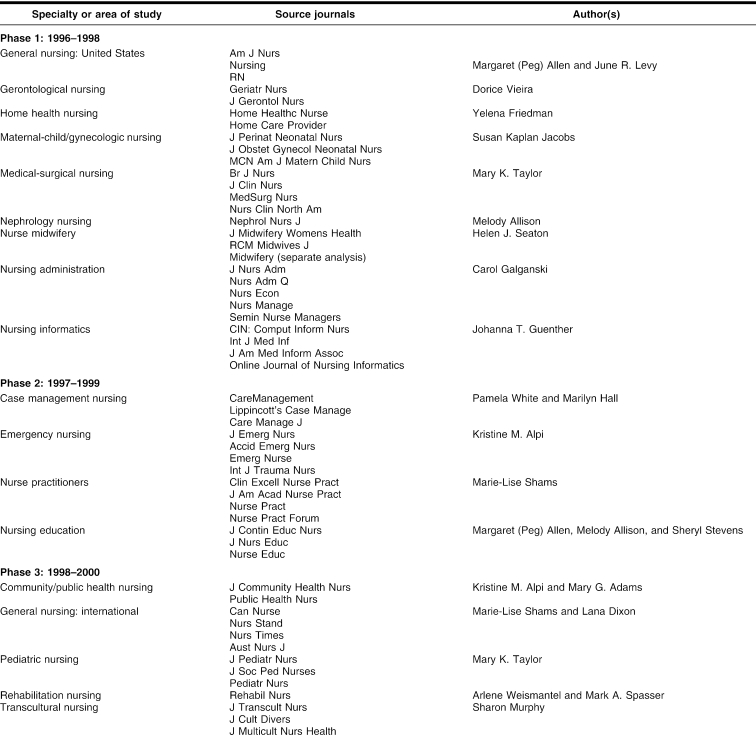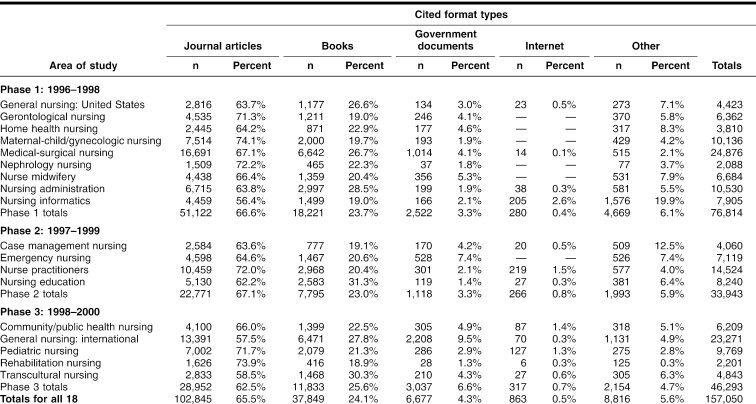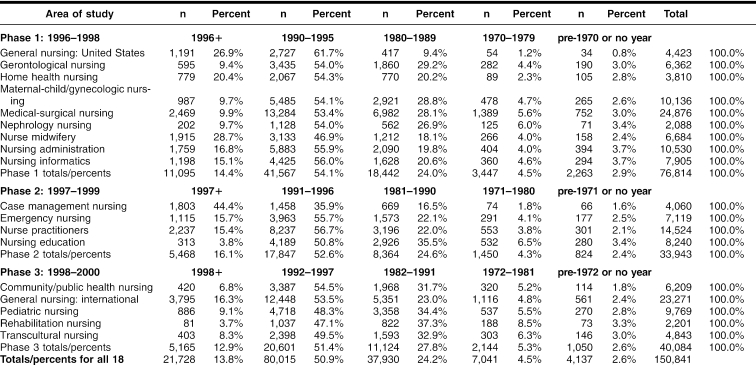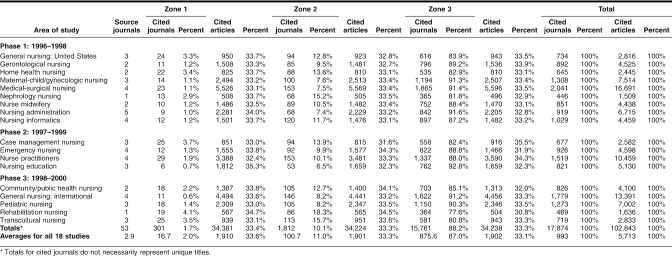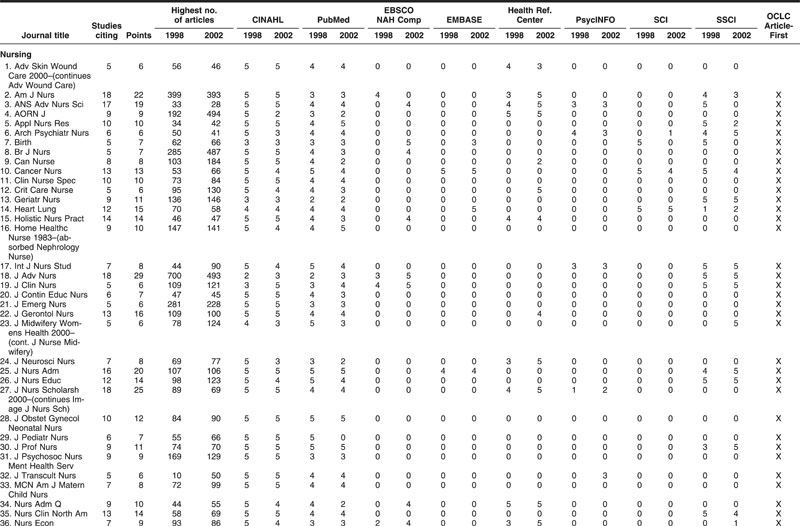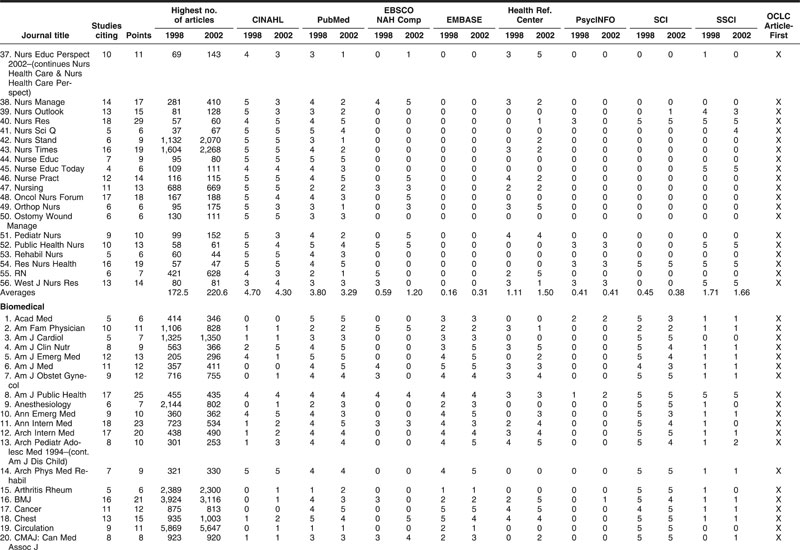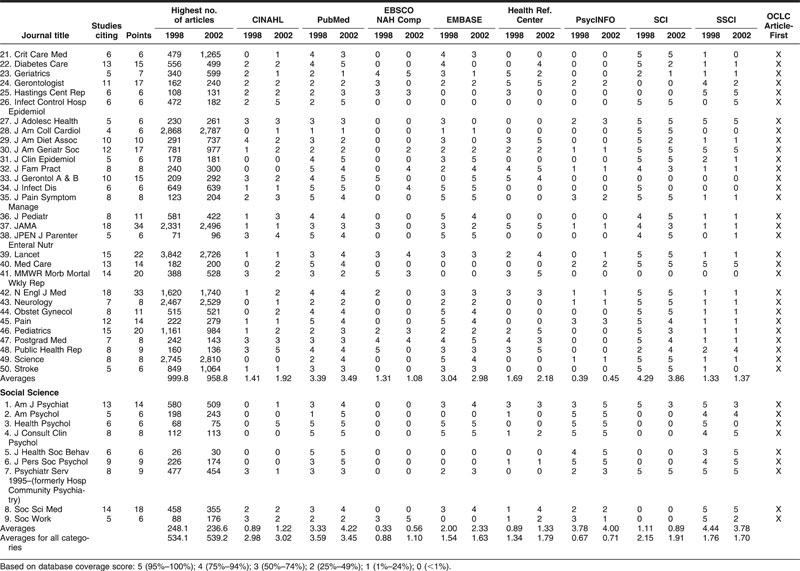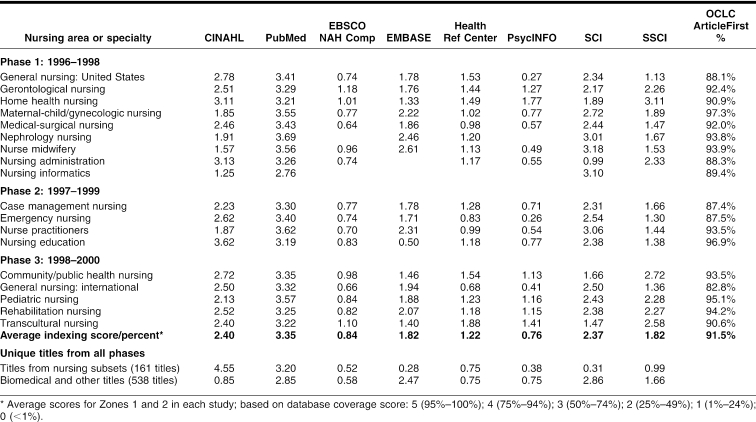Abstract
Introduction: This project is a collaborative effort of the Task Force on Mapping the Nursing Literature of the Nursing and Allied Health Resources Section of the Medical Library Association. This overview summarizes eighteen studies covering general nursing and sixteen specialties.
Method: Following a common protocol, citations from source journals were analyzed for a three-year period within the years 1996 to 2000. Analysis included cited formats, age, and ranking of the frequency of cited journal titles. Highly cited journals were analyzed for coverage in twelve health sciences and academic databases.
Results: Journals were the most frequently cited format, followed by books. More than 60% of the cited resources were published in the previous seven years. Bradford's law was validated, with a small core of cited journals accounting for a third of the citations. Medical and science databases provided the most comprehensive access for biomedical titles, while CINAHL and PubMed provided the best access for nursing journals.
Discussion: Beyond a heavily cited core, nursing journal citations are widely dispersed among a variety of sources and disciplines, with corresponding access via a variety of bibliographic tools. Results underscore the interdisciplinary nature of the nursing profession.
Conclusion: For comprehensive searches, nurses need to search multiple databases. Libraries need to provide access to databases beyond PubMed, including CINAHL and academic databases. Database vendors should improve their coverage of nursing, biomedical, and psychosocial titles identified in these studies. Additional research is needed to update these studies and analyze nursing specialties not covered.
INTRODUCTION
The Task Force on Mapping the Nursing Literature was created in 1999, based on the successful and award-winning Task Force on Bibliographic Access for the Allied Health Literature [1, 2]. This project is ongoing under the auspices of the Research Committee of the Nursing and Allied Health Resources Section of the Medical Library Association. Using a standard methodology for citation analysis, the study ranks cited journals to identify frequently cited titles and identify corresponding indexing sources. This overview compiles the results of eighteen completed studies. Additional studies are in progress, with plans to update some of the studies reported here.
Health sciences librarians mediate the gateway to the published literature and are positioned to select resources and to aid researchers in navigating the increasingly complex print and electronic environment. Nurses need access to literature to integrate objective data with subjective experience as they apply scientific knowledge to assessment and treatment [3]. Modeled on the allied health studies, the data presented here provide a “snapshot in time of the state of the literature” [4]. Citation analysis studies guide readers to relevant and useful journals and databases for a given specialty. This information is primarily relevant for librarians responsible for collection development and maintenance; it is also needed for librarians directing researchers to appropriate information resources and for nurse researchers looking at communication patterns in nursing. This research may also influence bibliographic database producers in their selection of journals to be indexed for various nursing specialties.
The first articles mapping the literature of allied health were published in 1997 [4, 5]. They utilized an information science theory, Bradford's Law of Scattering, which states that “for any specialty, a relatively small core of journals can be expected to account for a disproportionate amount of the literature” [6]. Bradford's law has been corroborated by bibliometric studies in other science and social science disciplines [1, 4, 7, 8]. Garfield characterizes this phenomenon as a: “concentration effect,” where “the few account for the most” [9].
MAPPING THE LITERATURE OF NURSING
Based on the premise that the journal literature is the primary vehicle for communication between nursing research and practice (in addition to monographs, proceedings, books, reports, and the popular press), this study aims to determine:
What resources does the nursing literature cite?
What formats are most frequently cited?
Which journal titles are most frequently cited?
Which databases best access these titles?
NURSING KNOWLEDGE
Professional nursing is defined by the American Nurses Association as: “the protection, promotion, and optimization of health and abilities, prevention of illness and injury, alleviation of suffering through the diagnosis and treatment of human response, and advocacy in the care of individuals, families, communities, and populations” [3]. Nurses are encouraged to use the best evidence to assess, plan, implement, and evaluate outcomes of patient care across a broad range of settings and populations. The knowledgebase for nursing practice includes “nursing science, philosophy, and ethics as well as physical, economic, biomedical, behavioral, and social sciences” [3]. Barriers to nurses' use of research have been identified as “time constraints, limited access to the literature, lack of training in information seeking and critical appraisal skills, a professional ideology that emphasizes practical rather than intellectual knowledge, and a work environment that does not encourage information seeking” [10]. Nurses tend to use what they learned in professional training, supplemented by experience gained from practice and from peers [10–12].
In the United States, the National Institute of Nursing Research provides leadership and funding for nursing research [13]. Its themes highlight the interdisciplinary scope of nursing practice, addressing bio-psychosocial issues, ethnicity, cultural diversity, lifestyle, chronic illness and end-of-life care, family caregiving, health disparities, and integration of new technologies with human factors. Nursing practice is often characterized as qualitative (e.g., beliefs and experiences, emotions such as hope, despair, empathy, attitudes), for which data are not easily measured [10, 14].
Advances in information technology have radically impacted health care delivery and nursing education [15]. Electronic access to information has enabled end users to conduct their own literature searches, with a focus on evidence-based practice and critical evaluation. This approach promotes “quality filtering” as a strategy to connect research to practice by providing access to synthesized, evaluative information such as reviews, clinical guidelines, randomized controlled trials, systematic reviews, and meta-analyses, information suitable for clinical application [16–25]. Bibliographic access to the current literature of nursing is primarily provided by the CINAHL and MEDLINE databases, online library catalogs, and the Internet. The Interagency Council on Information Resources for Nursing regularly updates Essential Nursing References as a guide to the wide variety of reference sources appropriate for nursing research [26].
Bibliometric nursing research
Bibliometric studies are not easily compared, because they tend to measure different variables. In 1984, Garfield examined citation patterns in seven nursing journals [27]. Analyzing three years of data, he ranked the most productive journals and analyzed “impact factors.” Results of this study prompted Garfield to comment on the highly interdisciplinary nature of nursing.
Other studies of the literature of nursing have addressed the citing-cited relationship. O'Neill studied a sample of CINAHL articles published in 1989 and found that most citations were from disciplines other than nursing. Results indicated that medical journals were cited more often by authors of nursing practice articles [28, 29]. A subsequent bibliometric study by DiCenso and others analyzed the approximately 140 clinical journals considered by Evidence-Based Nursing [30]. It found that 51% of the 192 articles abstracted over a 2-year period, 1998 to 1999, were originally published in 10 journals, only 2 of which were specifically written for nurses. The authors concluded that nurses seek publication in both nursing and non-nursing journals, that research relevant to nursing includes articles written by nurses and others, and that these articles are published in general health care journals as well as nursing-specific titles.
Other core lists
In addition to empirical data, the three Brandon/Hill selected lists—for nursing, allied health, and the small medical library—have been frequently cited sources of qualitative guidance for collection development [31–33]. In 2004, it was announced that the Brandon/Hill lists would be discontinued [34]. Allen's 2001 list of Key and Electronic Nursing Journals lists 256 nursing journals, noting the peer-review status, percent of research articles, inclusion on core or “recommended title” lists, indexing sources, and online availability of each [35, 36]. Murphy's annotated lists of nursing research journals identifies sources for both authors and librarians and provide indexing information, historical notes, and trends [37, 38].
The ISI “impact factor,” a tool used to rank and compare journals in a subject area, is defined as “a measure of the frequency with which the ‘average article' in a journal has been cited in a particular year or period” [39]. In the 2003 Journal Citation Reports, the ISI nursing category for the Social Sciences Citation Index (SSCI) included thirty-one titles. The value of ISI's rankings by impact factors has been debated, noting that they are a quantitative measure and should be considered with other criteria when evaluating journal titles [40, 41]. The strength of the impact factor reflects only those journals selected for the ISI databases, which generate the data [39, 42].
Plutchak observes that the Brandon/Hill lists and the ISI impact factors represent two ends of the spectrum, ranging from subjective analysis (qualitative) to evidence based on data (quantitative), but that the recommendations should not be “mechanically applied” [40]. Resource selection must be mediated by professional judgment and individual circumstances.
METHODOLOGY
As noted in the initial reports on the allied health research, bibliographic references provide a measurable path of information transfer, a quantitative way to assess core journals and dispersion beyond the core [1]. At an organizational meeting held at MLA '99, the 1999 MLA annual meeting, task force members identified nursing areas to be studied to ensure that the full breadth and scope of the nursing profession would be covered by the research project and volunteered for individual studies, including those summarized here.
Using the methodology described by Schloman and revised for nursing [43], members identified “source journals” for each study. Titles were identified through sources such as core lists and the official journals of the professional nursing associations [36–38]. Cited references from the articles in these source journals were analyzed for a three-year period, noting format, year, source, and notes.
Initial results and the research process were presented at MLA 2000 and MLA 2001 [44, 45]. As of July 2005, final tables have been created for the eighteen studies identified in Table 1. Results reported here are based on citation data from fifty-three source journals selected for these areas. Additional nursing specialties have been identified for future study, including major areas such as critical care, oncology, perioperative, and psychiatric nursing.
Table 1 Nursing studies and source journals
Authors recorded selected citation elements in database or spreadsheet software, including format, publication year, and cited journal titles. Citations to the journal literature were then sorted by “cited journal title” to determine core titles in each area of study. Zone 1 includes those journals holding the top third of the cited articles, with Zone 2 representing the middle third. Results were reported to Allen, who developed the master title coverage worksheet [46], so that potentially relevant databases could be checked for the cited journals appearing in Zones 1 or 2 for any of the studies. Members were careful to distinguish between US and UK titles with the same name, for example, Nursing Management. Journal title authority work identified several title changes in cited journals since the time of the initial research. All results are reported under the current (or last published) title for each journal as of early 2005.
The next steps addressed the final two questions posed for this study:
Which journal titles are most frequently cited?
Which databases best access these titles?
Six hundred ninety-nine unique journal titles appeared in Zones 1 or 2 in any of the 18 studies. These titles were placed in a “master title coverage” worksheet [46] to determine database coverage for each of the cited journal titles. Volunteers searched the 699 cited journal titles for the chosen reference year (1998) in each of the 12 databases noted below. The year 1998 was selected as the most current year for the initial group of studies that covered 1996 to 1998 (Phase 1), and only this year is included all 3 phases.
The 12 databases selected for this study were those often used in US academic and health sciences libraries. CINAHL was selected because of its strong coverage of the nursing literature. PubMed/MEDLINE, including citations previously in HealthSTAR, was selected as the most widely used database covering the biomedical literature. The other databases were chosen due to their potential relevance, adding psychosocial resources—PsycINFO, Social Sciences Citation Index (SSCI), and Sociological Abstracts—to those databases traditionally known for their biomedical coverage— EMBASE and Science Citation Index (SCI). EBSCO Nursing & Allied Health Collection Comprehensive Edition and Gale Health Reference Center full-text collections were included as examples of aggregated full-text resources for nursing and allied health. Three databases had minimal relevance: EBSCO Health Business, ERIC, and Sociological Abstracts. They are omitted from the combined tables and only discussed in those studies where they provided significant coverage. Finally, OCLC ArticleFirst, an index to over 15,000 journals in various fields, was selected as a popular current awareness tool. Journal selection is based on titles included in major indexing and abstracting services and the holdings of OCLC member libraries, so it includes many titles held by libraries serving nursing programs in academic settings [47].
Database coverage scores were determined next. To establish the total number of articles published, the authors relied on the counts of reference year (1998) articles that were indexed in those databases claiming complete coverage. Journal coverage percentages were calculated based on the highest number of articles indexed for 1998 by any of the databases. Each database was then given a score for the percentage of those articles that it included, based on the following scale: 5 (95%–100%); 4 (75%–94%); 3 (50%–74%); 2 (25%–49%); 1 (1%–24%); 0 (< 1%). (This scale is identical to that used for the allied health mapping project [1].) Note that this process resulted in lower scores for databases with indexing policies that might not include all types of articles. For example, if a journal published meeting abstracts and a database included each abstract as a separate article, the count would be much higher than that for other databases where indexing was limited to defined types of articles. The two full-text databases often yielded the highest article counts for the titles they included, because they claimed to provide “cover to cover” access for the full-text titles.
The process had significant challenges, including difficulty in limiting results to publication year in the ISI Web of Knowledge interface. Near the end of this process, the authors also found that the article counts for OCLC ArticleFirst were unreliable, with many duplicate entries artificially inflating the coverage score for this resource. Because it was not possible to go back and visually recheck all the coverage data for duplicates, OCLC ArticleFirst was removed from the scoring process and coverage scores were recalculated. Because several journal titles were not found in any other database, authors were encouraged to note and comment on the number of titles covered by this database.
RESULTS
The combined results represent data from 157,050 cited references appearing in the 53 source journals selected for the 18 studies. Citation patterns were relatively consistent during the 5-year period (1996–2000). Tables 2 and 3 provide data summarizing answers to two of the four questions posed earlier:
What resources does the nursing literature cite?
What formats are most frequently cited?
Table 2 Cited formats by area of study
Table 3 Publication years of cited references by area of study
Formats cited
Table 2 shows that journals accounted for 102,845 citations, or 65.5% of the total. For all areas studied, cited journals represented the largest percentage of cited references, ranging from a low of 56.4% for nursing informatics to a high of 74.1% for maternal-child/gynecologic nursing. This range is lower than that shown for the first 5 allied health studies, where journals were cited from a low of 63.1% (speech-language pathology) to a high of 90.5% (respiratory therapy) [1]. Interestingly, the book and journal percentages for rehabilitation nursing are relatively close to those for physical therapy, 2 specialty areas that rely on a common interdisciplinary body of knowledge. Percentage of books cited ranged from a low of 18.9% (rehabilitation nursing) to a high of 31.3% (nursing education). Books were cited most often by nursing administration, nursing education, and transcultural nursing.
Citations to government documents ranged from a low of 1.3% (rehabilitation nursing) to a high of 9.5% (general nursing: international). Task force members were also encouraged to record Internet Web page citations, excluding journal citations that included online uniform resource locator (URL) information. When reported, citations to Internet resources were minimal. The highest percentage was 2.6% for nursing informatics, even though this study covered the literature for the earliest time period. Future studies should be required to include Internet as a separate category.
Age of cited references
Age of cited references was analyzed, with results combined in Table 3. Year ranges were adjusted for each 3-year phase, so that each range spanned the same number of years. Combining data for the 2 most recent ranges illustrated that literature less than 7 years old was cited more than 60% of the time by most studies. Older literature was rarely cited, with summary tables combining the oldest ranges.
Cited journals
Each study ranked journal titles in order of decreasing utilization. Bradford's Law of Scattering was applied to mark three zones with those journals providing the top one-third of the citations comprising Zone 1 and the remaining thirds, Zones 2 and 3, respectively. Table 4 demonstrates Bradford's law, with a small percentage of journal titles accounting for the top and middle third in each study. The percentage of cited titles in Zones 1 and 2 was relatively consistent across Phases 1, 2, and 3, averaging 2% for Zone 1 and 11.1% for Zone 2. Ranges were from 0.6% to 4.1% for Zone 1 and from 6.5% to 18.3% for Zone 2. The number of cited titles in Zones 1 and 2 had some variation, with just 6 Zone 1 titles for nursing education, the least clinically oriented specialty studied. The highest number in Zone 1 was 29 for the nurse practitioner study, arguably the most “medical” of the nursing specialties. Cited journal title counts in Zone 2 ranged from a low of 53 for nursing education to a high of 153 for both medical-surgical nursing and nurse practitioners. Overall citation counts were lower for studies with fewer source journals.
Table 4 Dispersion of cited journals by zone
Database coverage
Authors reported the scores for the Zone 1 and 2 titles for their studies, including all databases with the best coverage for the index year (scores of 5 or 4). Table 5 notes the top 115 titles across all of the 18 studies. These titles received at least 6 points when applying a weighted formula awarding 2 points for each study citing the title in Zone 1, and 1 point for each in Zone 2. Combining titles in Zones 1 and 2 in Table 5 masks the distinction between the heavily cited “core” titles and those titles among which citations are more widely dispersed. As Corby has observed, however, the relevant outcomes of core lists are to be found at the “edges of the core” [48]. It is assumed that most academic institutions and hospital libraries would agree to include the smaller number of Zone 1 titles in their collections. Zone 2 may prove more significant when determining library collection decisions.
Table 5 Coverage of most frequently cited journals (115 titles)
To determine whether database coverage was changing for these frequently cited titles, 2002 database coverage was also checked. Three subject groupings are listed in the table—nursing, biomedical, and social science—with separate averages computed for each group, as well as overall averages. Nursing journals are defined as titles appearing in the “Nursing” journal subsets for CINAHL or MEDLINE [49, 50]. Remaining titles with a psychosocial focus are grouped together as “social science.”
Each of the 115 journals in this table was included in Zones 1 or 2 for at least 4 studies and received at least 6 points in the scoring. Only 8 journal titles appeared in the lists for all 18 studies. Four of these are nursing titles: American Journal of Nursing, Journal of Advanced Nursing, Journal of Nursing Scholarship, and Nursing Research, 3 of which are known for publishing nursing research. The top 4 biomedical titles are not surprising: American Journal of Public Health, Annals of Internal Medicine, JAMA, and New England Journal of Medicine, with the weekly titles publishing a large number of articles and receiving the highest number of points. Just 71 titles (10.2% of all 699) appear in Zones 1 or 2 for 8 or more studies. This analysis suggests that the “core” for the studied nursing areas is remarkably small.
Given the smaller number of articles published by nursing and social sciences journals in a calendar year, it is remarkable that so many nursing titles—56 journals (48.7%)—appear in the top 115. Table 5 demonstrates that CINAHL provides the best coverage for the listed nursing journals, with average scores above 4.30 for both 1998 and 2002. PubMed/MEDLINE coverage of nursing journals earns average scores above 3.29 for both reference years. SSCI came in as a distant 3rd, with Health Reference Center and the EBSCO collection demonstrating improved but limited coverage.
Database coverage scores for biomedical titles are 3.0 or higher for PubMed/MEDLINE and EMBASE, with SCI providing the most extensive coverage for these titles. The social science scores for PubMed/ MEDLINE, PsycINFO, and SSCI are relatively close. Each of these databases scores 5 for 5 or 6 of the 9 social science journal titles in 2002, and all should be considered for comprehensive searches on psychosocial topics.
Average indexing coverage for key databases
The average indexing scores noted in Table 6 reflect the interdisciplinary nature of the cited journals for each study. Because many authors commented on the differences in database coverage of nursing journals, the database scores were also averaged for two title lists: one for nursing (160 titles) and one for biomedical and other titles (538 titles). As a true index, PubMed/ MEDLINE offers the best overall access to the cited journals in Zones 1 and 2. The average database coverage score was highest for PubMed/MEDLINE for all studies except nursing informatics, where SCI provided the best coverage. The CINAHL database ranked second for most studies, with the other databases well behind the leaders.
Table 6 Average indexing coverage for key databases*
Table 6 also demonstrates the minimal coverage of the nursing literature by the ISI citation databases. Of the forty-one nursing titles currently indexed in SSCI, four were not included in Zones 1 and 2 for any of the eighteen studies. Eight of the remaining thirty-seven were not indexed by SSCI as of 1998, leaving just twenty-nine with 1998 coverage scores.
Low average database coverage scores for the two full-text databases are easily explained by the relatively low number of titles included in these collections. The EMBASE results for nursing are quite low. Note that all EMBASE results are based on the EMBASE/ Excerpta Medica database produced by Elsevier Science, not the enhanced EMBASE.com database, which includes all MEDLINE titles—including nursing subset titles—that are not indexed by EMBASE.
While not reliable for article counts, OCLC ArticleFirst is a good resource for accessing articles in journals that are not indexed in the databases listed here. This resource is the only source of coverage for eight of the twenty-four currently published journal titles that are not indexed in any of the other checked databases [46]. Nurses and librarians should investigate other sources for current awareness, such as PREMEDLINE, PreCINAHL, and Web-based alerting services offered by journal publishers, aggregators, and professional Websites [51].
DISCUSSION AND LIMITATIONS
As noted by Corby, librarians consulting core lists to make selection decisions should focus their efforts beyond heavily cited core titles. Corby also addresses the “self fulfilling prophecy” phenomenon [48]. If librarians base remote storage and cancellation decisions on core lists, those less accessible items may be cited less frequently. The data cited here might reflect this to some extent. Access to full text (print or electronic) is always a barrier that may skew the references cited in any research project, as are searching skills, personal preferences, and ease of retrieval. Access is ultimately limited by the indexing policies and methods of journal selection used by database providers. Pravikoff asks whether decisions will be based on the best evidence or only the best available resources [52]. While authors bear the responsibility for doing the best possible search, what happens when their libraries or the indexing services do not provide access to all the evidence?
This study is based on data derived from citing authors' research practices prior to widespread use of the Internet, migration of databases to Web-based platforms, and availability of electronic full text. An open access movement to disseminate biomedical research online free of charge has emerged to compete with the existing business model. Initiatives with open access objectives include the Public Library of Science (PLoS) and BioMed Central [53, 54]. This revolution in scholarly communication and access suggests that repeating these studies and comparing results with older data will produce a different “core.”
The use of the data summarized here should acknowledge the limitations posed by the selection process that generated the source journals to be analyzed. While the project protocol established criteria for source journal selection, judgment of the individual authors influenced selection [43]. In addition, many key nursing specialties proposed for this study are not included or are in progress. The effort required to “score” database coverage did not yield reliable article counts, due to the wide variation in database practices. Checking which titles were covered by each of the databases would have provided sufficient data.
These factors need to be considered in designing future studies, as well as in interpreting results. Systems for managing aggregate and individual electronic subscriptions ought to provide for analysis of individual title use. Subjective advice should be sought from nursing professionals, balanced with local usage data and realistic cost-justification decisions. Decisions should be made based on local needs, not simply by consulting core lists.
The phenomenon of “uncitedness” recognizes that some journal use is never reflected in published citations (e.g., clinical review titles) but can be important elements of library collections and indexing services that are necessary for educational and clinical reference [55, 56]. Garfield observes that many publications “are written and read primarily for some purpose other than the communication of original research findings” and are essential to library collections [57]. Evidence-based librarianship “seeks to improve library practice by utilizing the best-available evidence combined with a pragmatic perspective developed by working experiences in librarianship” [58]. In the end, both professional judgment and data are important [40, 48].
Quantitative data do not tell the whole story. While librarians need empirical data to back up their collection decisions and reference advice, ultimately the mediation of a researcher's search process requires considering the scope and focus of the individual topic. Bates observes that the experience of the searcher is “phenomenologically different” from the indexer's experience [7]. In reality, searchers' decisions begin with the research topic. The focus of the search may change because the search process is iterative. The human factors include a researcher's initial choice of a database as well as choice of search terms. An indexer describes a citation using a controlled vocabulary; the searcher uses natural language and may naively use broader or narrower search terms. A search focused on a psychosocial aspect of nursing (e.g., “NICU and depression”) requires a different strategy than a search focused on a biomedical aspect (e.g., “NICU and medication errors”). While many relevant articles may be concentrated in a few journal titles, more extensive searching is necessary to locate more widely dispersed articles. Thus, although these studies point at indexing sources that best access frequently cited journals, common sense and human mediation must prevail and selection of databases depends on the topic. As Bates observes, “Desired material is neither perfectly concentrated in one place as we might hope, nor is it completely randomly distributed either, as we might fear” [7].
For currency and thoroughness, it is helpful to augment searches in thesaurus-based databases with OCLC ArticleFirst and the ISI citation indexes. National library catalogs and the Internet should be searched for non-journal resources. For thorough systematic reviews, it is also important to do hand searches of relevant titles.
CONCLUSION
This research represents a “snapshot in time” of the citation patterns for general nursing journals and selected nursing specialties over three of the five years from 1996 to 2000 [4]. It underscores the interdisciplinary nature of nursing as a profession. Lists of top-cited titles guide collection development decisions for libraries supporting each of the nursing specialties, as well as the core represented by the general nursing studies. These results cannot be extended to those specialty areas not yet studied.
Database coverage results point to the need to search multiple sources when researching nursing topics. The CINAHL database has continued to expand its coverage to include more biomedical resources in addition to its traditional strength in nursing and allied health and should be recognized for this effort. Search results for nursing topics in ISI databases might be skewed, masking the fact that nursing journals are not well represented in this “interdisciplinary” resource. Current database coverage lists should be consulted to verify the most recent indexing status of the cited journal titles. It is important to recognize that this research captures one time period and does not necessarily represent current citation patterns of the eighteen nursing areas studied.
This research should be replicated for other nursing specialties and updated for the studied areas. Will more recent nursing literature reflect increased reliance on the Internet and online journals? Will the evidence-based practice movement lead to broader dispersion patterns as nursing attempts to translate research into practice? Will the “open access” movement broaden access as well as choices for researchers and authors? All of these trends are likely to affect citation patterns. Future studies should be designed to answer these questions and not simply replicate the research presented here.
Acknowledgments
Thanks to Barbara F. Schloman, AHIP, and the allied health task force for taking the plunge with this initiative and providing the model for our project. Ginny Chaskey and Cinahl Information Systems provided data for the cited references for many titles, saving large amounts of time for many task force members. Susan Kaplan Jacobs, AHIP, Dorice Vieira, and Jennifer Schwartz designed an Access database with instructions to help analyze citations, which they shared with other researchers. Diane S. Pravikoff, director of research for Cinahl Information Systems, helped edit the final tables and manuscript.
The database-checking volunteers who provided consistent data for the cited journal tables include Margaret (Peg) Allen, AHIP, Melody Allison, Kristine M. Alpi, AHIP, Carol Galganski, AHIP, Martha (Molly) Harris, AHIP, Helen Seaton, AHIP, Priscilla Stephenson, AHIP, Mary K. Taylor, AHIP, and Pamela White.
Also, thanks to the volunteers who provided initial peer review of completed papers for the individual nursing specialty studies and this overview. In addition to the authors, task force members whose contributions extended beyond completing their own studies included: Allison, Alpi, Ruth Fenske, AHIP, Seaton, Stephenson, and Vieira. Alpi manages the NAHRSMAP task force mailing list in Yahoo Groups. She also helped coordinate the internal peer-review process with the assistance of Laura Larsson and DocReview, a collaborative document reviewing tool used for internal review of some of the papers.
Footnotes
Editor's Note: The following article is an overview of the “Mapping the Literature of Nursing Project” sponsored by the Nursing and Allied Health Resources Section of the Medical Library Association. It provides an overview of the project and the combined results of eighteen individual studies examining the literature of various aspects of nursing. Fifteen of those individual studies are included in an online-only symposium <http://www.pubmedcentral.nih.gov/tocrender.fcgi?action=archive&journal=93> to this issue of the Journal of the Medical Library Association, available on PubMed Central.
Contributor Information
Margaret (Peg) Allen, Email: pegallen@verizon.net.
Susan Kaplan Jacobs, Email: susan.jacobs@nyu.edu.
June R. Levy, Email: jlevy@cinahl.com.
REFERENCES
- Schloman BF. Mapping the literature of allied health: project overview. Bull Med Libr Assoc. 1997 Jul; 85(3):271–7. [PMC free article] [PubMed] [Google Scholar]
- Medical Library Association. Ida and George Eliot Prize. [Web document]. Chicago, IL: The Association. [rev. 2004; cited 20 Feb 2005]. <http://www.mlanet.org/awards/honors/eliot.html>. [Google Scholar]
- American Nurses Association. Nursing's social policy statement. 2nd ed. Washington, DC: The Association, 2003. [Google Scholar]
- Schloman BF. Introduction. Bull Med Libr Assoc. 1999 Jul; 87(3):276. [PMC free article] [PubMed] [Google Scholar]
- Schloman BF. ed. Symposium: mapping the literature of allied health. Bull Med Libr Assoc. 1997 Jul; 85(3):269–302. [PMC free article] [PubMed] [Google Scholar]
- Bradford S. Documentation. London, UK: Crosby, Lockwood, 1948. [Google Scholar]
- Bates MJ. Indexing and access for digital libraries and the Internet: human, database, and domain factors. J Am Soc Inf Sci. 1998 Nov; 49(13):1185–205. [Google Scholar]
- Davis P. Where to spend our e-journal money: defining a university library's core collection through citation analysis. Portal-Libr Acad. 2002 Jan; 2(1):155–66. [Google Scholar]
- Garfield E. The significant scientific literature appears in a small core of journals. Scientist. 1996 Sep 2; 10(17):13. (<http://www.garfield.library.upenn.edu/commentaries/tsv10(17)p13y090296.html>. [cited 15 Dec 2005].). [Google Scholar]
- DiCenso A, Cullum N, and Ciliska D. Implementing evidence-based nursing: some misconceptions. Evid Based Nurs. 1998 Apr; 1(2):38–40. [Google Scholar]
- McKnight M. An observational investigation of on-duty critical care nurses' information behavior in a nonteaching community hospital. Dissertation,. University of North Texas, 2004. [Google Scholar]
- Pravikoff DS, Pierce S, and Tanner A. Are nurses ready for evidence-based practice? Am J Nurs. 2003 May; 103(5):95–6. [DOI] [PubMed] [Google Scholar]
- National Institute of Nursing Research. A brief history of the NINR: important events in the National Institute of Nursing Research history. [Web document]. Bethesda MD: The Institute. [rev. 2005; cited 14 Jan 2005]. <http://ninr.nih.gov/ninr/about/history.html>. [Google Scholar]
- Mulhall A. Nursing, research, and the evidence. Evid Based Nurs. 1998 Jan; 1(1):4–6. [Google Scholar]
- Heller BR, Oros MT, and Durney-Crowley J. The future of nursing education: ten trends to watch. [Web document]. New York, NY: National League for Nursing. [rev. 1998–2005; cited 19 Feb 2005]. <http://www.nln.org/nlnjournal/infotrends.htm>. [PubMed] [Google Scholar]
- McKibbon K, Marks S. Searching for the best evidence. part 1: where to look. Evid Based Nurs. 1998 Jul; 1(3):68–70. [Google Scholar]
- McKibbon KA, Marks S. Searching for the best evidence. Part 2: searching CINAHL and Medline. Evid Based Nurs. 1998 Oct; 1(4):105–7. [Google Scholar]
- Maragno J, Mitchell C, and Lewis D. Taking the library to the bedside: our experience with promoting evidence-based practice through literature databases. Bibl Med Can. 1999 Summer; 20(4):187–8. [Google Scholar]
- Allen M, Levy J. Evidence-based searching for nursing and allied health. Bibl Med Can. 2002 Spring; 23(3):90–5. [Google Scholar]
- Brown SJ. ed. Knowledge for health care practice: a guide for using research evidence. Philadelphia, PA: Saunders, 1999. [Google Scholar]
- Levy JR.. Searching the CINAHL database. part 1: evidence-based practice. Cinahl News. 2002;21(1):10. [Google Scholar]
- Craig JV, Smyth RL. eds. The evidence-based practice manual for nurses. Edinburgh, UK: Churchill Livingstone, 2002. [DOI] [PubMed] [Google Scholar]
- Jacobs SK, Rosenfeld P, Haber J.. Information literacy as the foundation for evidence-based practice in graduate nursing education: a curriculum-integrated approach. J Prof Nurs. 2003;19(5):320–8. doi: 10.1016/s8755-7223(03)00097-8. [DOI] [PubMed] [Google Scholar]
- Levy J.. Searching for evidence. Cinahl News. 2004;23(2):2–8. [Google Scholar]
- Allen M. Nursing knowledge: access via bibliographic and factual databases. In: Thede LQ, ed. Informatics and nursing: opportunities & challenges. Philadelphia, PA: Lippincott, 2003. [Google Scholar]
- Interagency Council on Information Resources for Nursing. Essential nursing references. Nursing Ed Perspectives. 2005 Sep/Oct; 26(5):300–9. [PubMed] [Google Scholar]
- Journal citation studies. 44. citation patterns in nursing journals, and their most-cited articles. [Web document]. Current Comments. [rev. 1984; cited 18 Feb 2004]. <http://www.garfield.library.upenn.edu/essays/v7p336y1984.pdf>. [Google Scholar]
- O'Neill AL, Duffey MA. Communication of research and practice knowledge in nursing literature. Nurs Res. 2000 Jul–Aug; 49(4):224–30. [DOI] [PubMed] [Google Scholar]
- O'Neill AL. Information transfer in professions: a citation analysis of nursing literature. Dissertation, The University of North Carolina at Chapel Hill, 1996. [Google Scholar]
- DiCenso A, Cullum N, Ciliska D, and Marks S. Evidence-based nursing: past, present, and future. Evid Based Nurs. 2000 Jan; 3(1):7–8. [Google Scholar]
- Hill DR, Stickell HN. Brandon/Hill selected list of print books and journals in allied health. J Med Libr Assoc. 2003 Jan; 91(1):18–33. [PMC free article] [PubMed] [Google Scholar]
- Hill DR, Stickell HN. Brandon/Hill selected list of print nursing books and journals. Nurs Outlook. 2002 May– Jun; 50(3):100–13. [DOI] [PubMed] [Google Scholar]
- Hill DR, Stickell N, and Crow SJ. Brandon/Hill selected list of print books and journals for the small medical library. [Web document]. Mount Sinai School of Medicine. [rev. 2003; cited 28 Jun 2005]. <http://www.mssm.edu/library/brandon-hill/small_medical/pdf/brandon4.pdf>. [Google Scholar]
- Brandon/Hill lists discontinued. MLA News. 2004 Aug; 368:4. [Google Scholar]
- Allen M. Nursing and Allied Health Resources Section, Medical Library Association. Key and electronic nursing journals: characteristics and database coverage, 2001 ed. chart. [Web document]. The Section. [rev. 2002; cited 13 Mar 2005]. <http://nahrs.library.kent.edu/resource/reports/keyjrnls_chart2001ed.pdf>. [Google Scholar]
- Allen M. Nursing and Allied Health Resources Section, Medical Library Association. Key and electronic nursing journals: characteristics and database coverage, 2001 ed., introduction. [Web document]. Kent, OH: The Section. [cited 23 Mar 2004]. <http://nahrs.library.kent.edu/resource/reports/keyjrnls_intro2001ed.pdf>. [Google Scholar]
- Murphy SC.. Nursing research journals: an annotated guide. Part II. Serials Rev. 2001;27(1):26–44. [Google Scholar]
- Murphy SC.. Nursing research journals: a discussion and annotated guide. Serials Rev. 1993;19(2):23–8. [Google Scholar]
- Thomson ISI. The impact factor. [Web document]. Philadelphia, PA: Thomson ISI. [rev. 1994; cited 2 Jun 2005]. <http://scientific.thomson.com/knowtrend/essays/journalcitationreports/impactfactor/>. [Google Scholar]
- Plutchak TS. The art and science of making choices [editorial]. J Med Libr Assoc. 2003 Jan; 91(1):1–3. [PMC free article] [PubMed] [Google Scholar]
- Frank M. Impact factors: arbiter of excellence? J Med Libr Assoc. 2003 Jan; 91(1):4–6. [PMC free article] [PubMed] [Google Scholar]
- Broome ME.. Reflections. Nurs Outlook. 2005;53(2):55–6. [Google Scholar]
- Task Force on Mapping the Nursing Literature, Nursing and Allied Health Resources Section, Medical Library Association. Mapping the literature of nursing project protocol. [Web document]. Kent, OH: The Section. [rev. Aug 2003; cited 14 Jan 2005]. <http://nahrs.library.kent.edu/activity/mapping/nursing/protocol.pdf>. [Google Scholar]
- Nursing and Allied Health Resources Section, Medical Library Association. Poster on mapping the literature of nursing. [Web document]. Kent, OH: The Section. [rev. 2000; cited 14 Jan 2005]. <http://nahrs.library.kent.edu/archives/annmtg/2000mtg/poster.html>. [Google Scholar]
- Jacobs SK. Nursing and Allied Health Resources Section, Medical Library Association. Cartographers of nursing literature: gathering the data for the mapping project. [Web document]. Kent, OH: The Section. [rev. 2001; cited 15 Jan 2005]. <http://nahrs.library.kent.edu/activity/mapping/nursing/jacobs2001.html>. [Google Scholar]
- Allen M. Master title coverage worksheet [unpublished research]. Mar 2005. [Google Scholar]
- ArticleFirst and ContentsFirst: database creation, quality control, enhancements, subjects represented, updating and indexing process. OCLC Newsletter. 1993 Mar; (202). 22–4. [Google Scholar]
- Corby K. Constructing core journal lists: mixing science and alchemy. Portal Libr Acad. 2003 Apr; 3(2):207–17. [Google Scholar]
- Cinahl Information Systems. Journals by categories/ subsets. [Web document]. Cinahl Information Systems. [rev. 2005; cited 19 Apr 2005]. <http://www.cinahl.com/library/library.htm>. [Google Scholar]
- US National Library of Medicine. List of journals indexed for MEDLINE, list of serials indexed for online users. [Web document]. The Library. [rev. 2005; cited 19 Apr 2005]. <http://www.nlm.nih.gov/tsd/serials/terms_cond.html>. [Google Scholar]
- New York University Libraries. Alerting services. [Web document]. The Libraries. [rev. 2005; cited 19 Apr 2005]. <http://library.nyu.edu/research/health/alerting.html>. [Google Scholar]
- Pravikoff DS.. The evidence-based practice dilemma. Cinahl News. 2004;23(1):6–7. [Google Scholar]
- Public Library of Science (PLoS). PLOS history. [Web document]. Public Library of Science. [rev. 2004; cited 28 Jun 2005]. <http://www.plos.org/about/history.html>. [Google Scholar]
- BioMed Central. What is BioMed Central? [Web document]. London, UK: BioMed Central. [rev. 1999–2005; cited 28 Jun 2005]. <http://www.biomedcentral.com/info/>. [Google Scholar]
- Stern RE. Uncitedness in the biomedical literature. J Am Soc Inform Sci. 1990 Apr; 41(3):193–6. [Google Scholar]
- Blecic DD. Measurements of journal use: an analysis of the correlations between three methods. Bull Med Libr Assoc. 1999 Jan; 87(1):20–5. [PMC free article] [PubMed] [Google Scholar]
- Garfield E. Citation analysis as a tool in journal evaluation—journals can be ranked by frequency and impact of citations for science policy studies. Science. 1972 178(4060):471–9.(<http://www.garfield.library.upenn.edu/essays/V1p527y1962–73.pdf>. [cited 19 Apr 2005].). [DOI] [PubMed] [Google Scholar]
- Eldredge JD. Evidence-based librarianship: an overview. Bull Med Libr Assoc. 2000 Oct; 88(4):289–302. [PMC free article] [PubMed] [Google Scholar]



